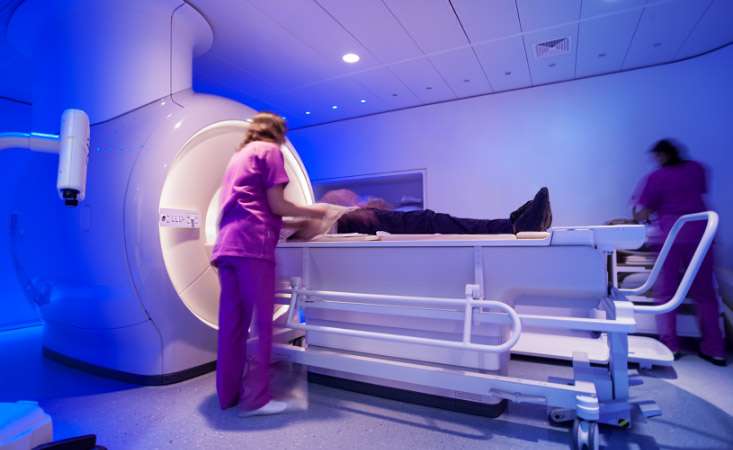
You may be hearing about full-body MRIs after television personality Maria Menounos revealed she was diagnosed with a PNET, also known as pancreatic neuroendocrine tumor or PanNET. Menounos has said in interviews and on social media that the full-body MRI she received led to her diagnosis of stage II pancreatic neuroendocrine cancer. Because her tumor was detected at a relatively early stage, she was able to have surgery to remove the cancer.
It’s important to note that PNETs are a rare form of pancreatic cancer that differ biologically and clinically from the more common pancreatic ductal adenocarcinoma (PDAC). The overall five-year survival rate for all pancreatic cancer is 12% and the five-year survival rate for PNETs is 53%. While PNETs and PDAC are two distinct types of cancer, doctors may use an MRI for both as a tool to inform diagnosis. Only a biopsy can tell with 100% certainty whether someone has pancreatic cancer and what type of cancer they have.
Here, we share more information about full-body MRIs, including current recommendations and how they differ from other types of imaging tests.
What is an MRI?
An MRI, or magnetic resonance imaging, uses radio waves and magnets to take pictures of organs and structures inside the body by measuring their energy. This is typically done while a patient lies on a table. A computer joins all the images and creates a 3D image. MRI is one of several imaging tests available to healthcare professionals to diagnose pancreatic cancer.
What is a full-body MRI? What makes this different from a regular MRI?
MRIs used for diagnostic purposes typically focus on one organ or cluster of organs after a patient is deemed high risk for a particular disease or presents with symptoms that warrant follow up. Some private companies are now offering full-body MRIs to the general public as an elective procedure. This means that people who are not showing any symptoms of cancer or other conditions can receive the scan without a physician referral.
PanCAN suggests talking to your healthcare team about any imaging tests you may be interested in receiving before moving forward. It’s important to understand the scan’s benefits and risks as well as specifics about how the images will be reviewed and interpreted.
What are the pros and cons of full-body MRI?
MRIs have several benefits as compared to other types of imaging tests. They do not expose patients to radiation. Also, tumors that are not visible on other scans sometimes appear on MRI scans.
There are also some cons to consider. As with any imaging test, there is the potential for false positive results.This may lead to unnecessary follow-up tests and procedures. It’s important to share results from any imaging tests with a physician or healthcare team familiar with your medical history as they are in the best position to help decide on a plan moving forward.
What kind of tests are available for people who are at risk for pancreatic cancer?
It’s important to understand your risk when it comes to pancreatic cancer. Learn more about risk factors and take PanCAN’s 10-question risk assessment test.
There is currently no universal screening test for pancreatic cancer. However, for those at higher risk for the disease, there are several imaging tests physicians can use to detect pancreatic cancer, including MRIs, endoscopic ultrasounds (EUS), endoscopic retrograde cholangiopancreatography (ERCP), CT scans and PET scans. Blood tests are also available that may aid in the detection of both PDAC and PNETs. Talk to your healthcare team if you are at higher risk for pancreatic cancer to determine the best strategy for your situation.
Is full-body MRI available to everyone?
Full-body MRIs are available to most people. However, it is important to remember that it is an elective procedure not covered by insurance. This means that the patient will have to pay full price for the test. The price of a full-body MRI can be as high as $3,000-5,000. If you decide to get this type of scan, please let your healthcare team know so they can interpret results. Full-body MRI does not replace regular visits with a primary care physician and standard screening protocols.
Why isn’t full-body MRI covered by insurance? Why hasn’t my doctor mentioned it to me?
Before an imaging test is recommended to be used for early detection or diagnosis, it must be researched and proven to be safe and effective by doctors and researchers. Full-body MRI still needs more research to determine whether it is more or less effective than imaging tests already available and whether using full-body MRI as an early detection method in asymptomatic people makes a significant difference in outcomes. The U.S. Preventive Services Task Force currently recommends against screening for pancreatic cancer in asymptomatic adults not known to be at high risk for the disease.
















